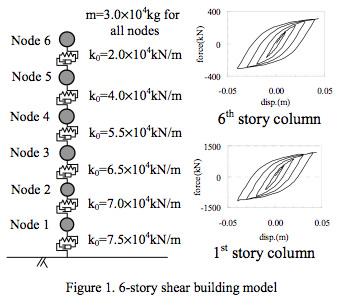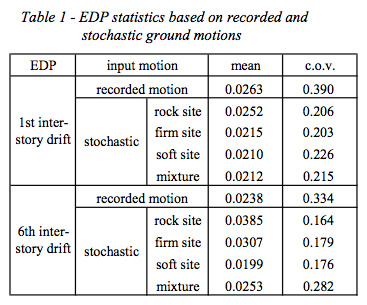Reliability of Degrading Systems - 4142005
| Project Title—ID Number | Reliability of Degrading Systems - 4142005 |
| Start/End Dates | 10/1/05 – /30/06 |
| Funding Source | PEER-CA Transp. Fund |
| Project Leader (boldface) and Other Team Members | Armen Der Kiureghian (UCB/F), Kazuya Fujimura (GS), Sanaz Rezae (GS) |
Project goals and objectives
The objective of this project is to develop a nonlinear random vibration approach that is appropriate for reliability analysis in the context performance-based earthquake engineering. The Tail-Equivalent Linearization Method (TELM) has already been developed in the previous phases of this project. For the present phase, the objectives are: (a) extend the method for non- stationary response, (b) apply to degrading systems, which necessarily require non-stationary analysis, (c) demonstrate the use of the TELM in the PEER PBEE framework, (d) complete and refine the implementation of TELM in OpenSees.
Role of this project in supporting PEER's mission (vision)
This project provides an alternative for computing the distribution of engineering demands parameters in the PEER PBE framework. Specifically, by using a stochastic model of the ground motion, the approach avoids the problem of selecting and scaling recorded ground motion time histories.
Methodology employed
TELM is an equivalent linearization method. However, in contrast to the conventional ELM which is a second-moment based method, it defines the equivalent linear system by matching the tail probability of the linear response with the first-order approximation of the tail probability of the nonlinear response. Methods used include stochastic modeling of the ground motion, the first-order reliability method, optimization algorithms, nonlinear time history analysis, and response sensitivity analysis.
Brief Description of previous year's achievements, with emphasis on accomplishments during last year (Year 8)
The development of TELM for stationary random vibration analysis was completed in Year 8. Extensive parametric studies were carried out to determine the characteristics of the tail- equivalent linear system and to determine the range of accuracy of the method. Example applications with building and bridge structures were carried out. The method has been implemented in OpenSees, though refinements in this implementation are still on-going. A paper on this development has been completed and submitted for publication. The work has also been presented in a keynote lecture at one conference.
Figure 1 and Table 1 present the results of an analysis with TELM for a six-story example hysteretic system subjected to stochastic ground motions. Table 1 compares the mean and coefficients of the interstory drifts as obtained by TELM and by the conventional PEER PBEE approach employing 10 scaled recorded ground motions. The comparison shows that the c.o.v. estimated by the conventional method is too high. We believe this is due to the site-to-site variability of recorded ground motions. It is also apparent that the TELM approach is able to properly account for the site conditions.


Other similar work being conducted within and outside PEER and how this project differs
Within PEER, many researchers are using the PEER PBEE approach based on selection and scaling of time history analysis. We are the only group developing an alternative. Outside PEER, we are not aware of any other work in nonlinear random vibration analysis that has similar objective and approach as ours.
Describe any instances where you are aware that your results have been used in industry
The approach is in developmental stage. It has not yet been used by the industry.
Expected milestones & deliverables
- Develop a new stochastic model for non-stationary ground motion appropriate for TELM analysis.
- Develop algorithms for TELM analysis of non-stationary response - June 2006.
- Investigate applications to degrading systems - August 2006.
- Demonstration of application to PEER PBEE analysis - Oct 2006.
- Implementation in OpenSees - October 2006.
Member company benefits
Having an alternative for PBEE analysis, which avoid selecting and scaling recorded time histories.
Back to Funded Project Archive main page

